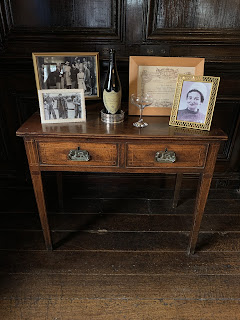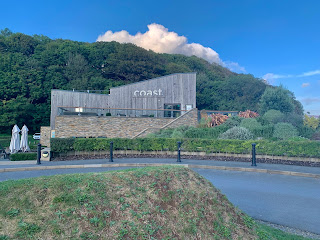Pembrokeshire was wonderfully relaxing, but low on the culture that usually makes up part of any annual girls’ trip. Fortunately, Cardiff sits half way between London and those beachy delights, and offers some sightseeing blockbusters just minutes off the motorway. Outbound, we wandered happily through one of the UK’s rare remaining Carolean houses, unaware that we were mere hours from a new Carolean age. On our return, it was a trip back to the imagined Middle Ages through the eyes of some very fanciful, and rich, Victorians.
Tredegar is an elegant red brick mansion on the outskirts of the Newport docks complex that once made the owners of both, the Morgan family, extremely wealthy. At first glance the house is definitively a product of the age of Charles II: simple lines outside, elegant proportions within, but festooned with decorative details. The gilded ironwork on the gates outside, the highly-carved wooden panelling inside, painted ceilings and ornate plasterwork all follow the design path Charles II was taking at Windsor Castle, but in a humbler, provincial way. Look closely at the marble columns in the magnificent gilt room and you’ll discover that they’re only painted to fool you into thinking they’re fancy, imported stone.The carved faces in the main hall are much closer to green men than the divine Greco-Roman faces that would have been typical in palaces.
You won't care about any of that when you stand in the Gilt Room, one of Tredegar's highlights.
Carolean is only half the story, however. The modern Morgans, particularly two of the later owners, were characters worthy of novels. Though one would be by Kipling and the other by Wodehouse. The author of empire would take on Godfrey Morgan, a rare survivor of the charge of the light brigade who came home to life as a fox-hunting country squire. There's a magnificent portrait of him with horse and hounds. He looks like the kind of man who values his pets as much as people, so it's no surprise to learn that he buried his horse from the Crimean War, Sir Briggs, with full military honours when he crossed the rainbow bridge age 28. Having never bothered to add a wife to his stable, Godfrey passed his estate to his nephew Courtenay, who seems quite a responsible sort. It was his outrageous son Evan who sent the Morgans of Tredegar out with a blaze of glory.
Evan's profligate spending is doubtless the reason the Morgans had to give up the place, but you can tell that the volunteers all have a fond spot in their hearts for him. The house was famous for its magnificent parties in the '30s, where no extravagance was spared. Evan sent a family-owned ship to Norway when the house needed for ice; evidently the Norwegian stuff is best in a gin and tonic. Despite being openly gay he married twice, both women finding lovers elsewhere. A display in one of the main drawing rooms tells the tale of these bright young things, including some costumes and personal items that bring the age to life. It's good to know that along with his other eccentricities, Evan is remembered for treating his staff unusually well.
Sadly we weren't able to get upstairs on our visit. Heritage properties are having the same staffing issues as everyone else, and the house manager told us that less than half of the former volunteers returned after Covid. They rarely have enough room stewards to open the house all at one time anymore, so have moved to a schedule of opening one floor in the morning and another in the afternoon. It's worth noting for future sightseeing visits to stately homes: you may need to plan a longer visit than in the past to be able to see everything, making sure you are there through the heart of the day.
Our visit on the return drive had some things in common with 20th c. Tredegar: incredibly wealthy owners who spent wildly, derived revenues from shipping traffic in Welsh ports and used their properties mostly as party palaces. But there, the similarity stops. Castell Coch is a Victorian fantasy of the Middle Ages rebuilt within an actual Medieval structure, and its creators ... the Marquis and Marchioness of Bute ... would likely have been horrified by Evan's sexual hijinx.
You are here to see just three main rooms. Sure, there are a few more, and a nice climb to the tower, plus a lovely exterior ... but three interiors will burn themselves into your brain. The Butes worked with Britain's foremost proponent of the neo-Gothic, William Burges, who was inspired by the look a French architect named Eugène-Emmanuel Viollet-le-Duc. (For other connections to Viollet-le-Duc on this blog, check out my articles on Vianden Castle and the Chateau de Menthon) The result is a fairy tale setting loosely linked to looks of the Middle Ages but then taking fantastic turns that even Walt Disney might find too extreme.
The first room is the banqueting hall, with stencilled, painted walls, a soaring wooden ceiling and a massive fireplace with a polychromed figure of a saint over it. Medieval tales of other saints are painted on the high arches below the wooden roof on either side. It's magnificent, and could easily stand in for the set of Ivanhoe or the like, but it's actually a bit austere. It's an amuse bouche for what comes next.
The drawing room may be he most beautiful room in Britain. It's octagonal, with a towering dome, but it's actually not that big. While you could jam 50 people in here for a standing cocktail party, it could actually be quite cozy for eight sitting before the fire. But it's hard to imagine anything communal happening in here because everyone is so stunned by the interior decoration they just want to shut up and look at it; it may be the most densely decorated room per square meter I've ever seen.
You can read the room in layers. First comes panelling from floor to shoulder height in a lovely green, with each rectangle within the panelling painted with botanically accurate representations of Mediterranean flowers. Next, from shoulder height to perhaps 16 or 20 feet above your head, is a sumptuous painted mural of wildlife in the natural world. Look closer, however, and the fox, the crow, the ape, the tortoise, the hare et al are actually engaged in scenes from Aesop's fables. Moving up again, you reach the sky, with birds of the world flying through a space that's twilight at the bottom and full dark, spangled with stars, up top. The ribs of the vaults are decorated with butterflies, reminding us of the fragility of life. And up top, a blazing disc at the centre of the dome, is the sun which gives that life. Continuing along the theme of appreciating the life we're given, the fireplace is topped with near life-sized figures of the three Greek fates, spinning, measuring and cutting the string that represents a man's time on Earth. Every flower, animal, plant, bird and human is painted in such detail you could spend half an hour just looking at a square metre of the place. It is an astonishing space, made all the better if you get one of the knowledgeable human guides going into more depth than what's on your included audio guide. Head upstairs, passing through Lord Bute's bedroom ... memorable somewhere else but a sideshow here ... and reach Lady Bute's spectacular chamber. It is not quite as decoratively dense at the drawing room below, so not quite as jaw dropping, but it's close. The walls at human level are papered in a geometric design, saving your attention for the dome over this round space. It appears to be an enormous trellis separating you from a sunny blue sky, entwined with grape vines that are strangely laden with pomegranates. Exotic birds appear once more and, rather surprisingly, a troupe of jolly monkeys making merry. The ceiling is so arresting you hardly notice the suite of furniture created for her ladyship, all designed and painted in the Moorish-Gothic style. It's Aladdin meets Sleeping Beauty.There are other bits you can clamber around but, honestly, save your time. Come here for the drawing room and Lady Bute's bedroom, and drink your fill.
Tredegar and Castell Coch are brilliant reminders that Cardiff is awash with things to see. Maybe a future girls’ trip should head there? But I suspect that will be no time soon. After three years on home shores, there’s a plane in our future for Girls’ Trip No. 23.



































